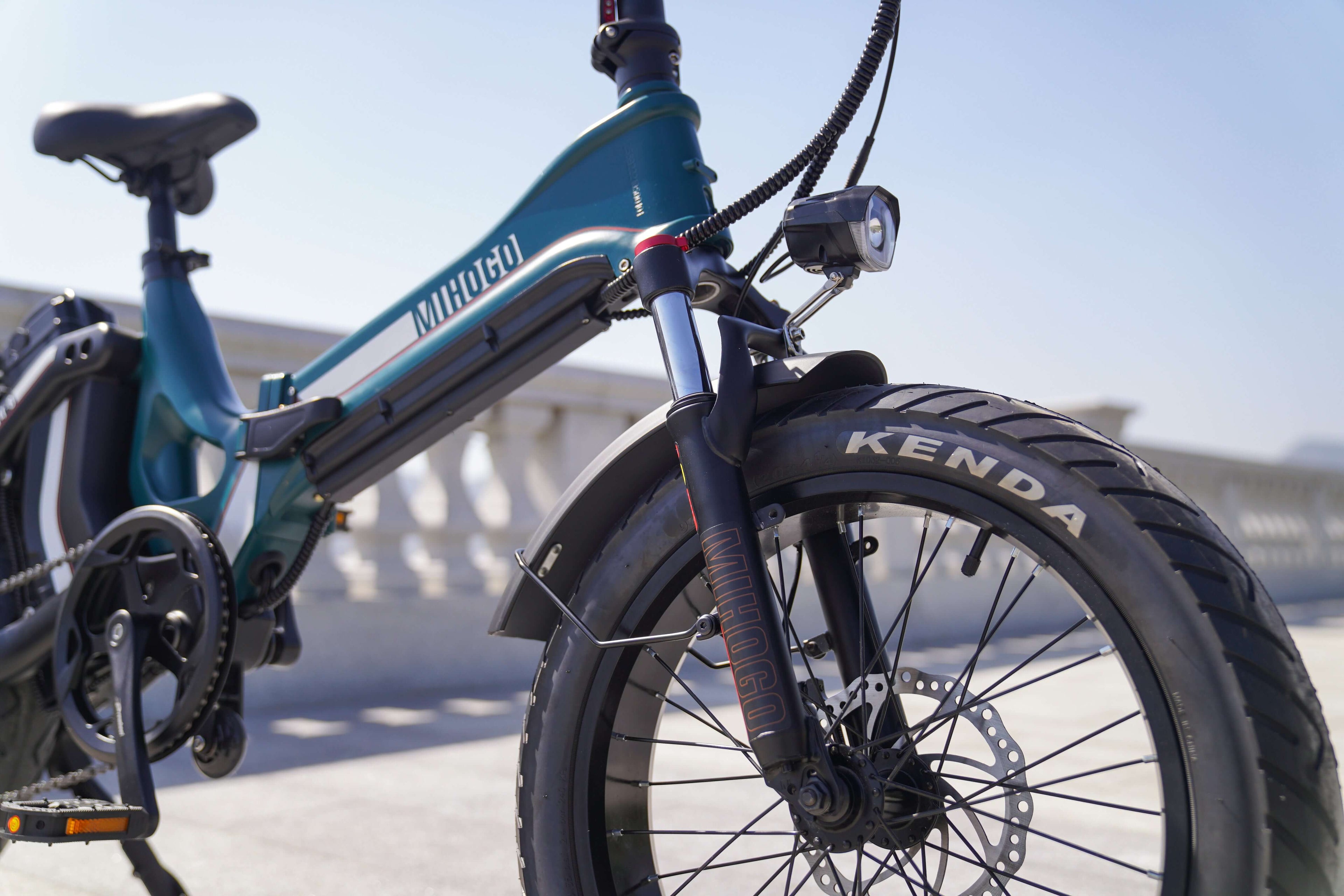What is Pay-Per-Mile E-bike Insurance?
Pay-per-mile insurance represents a paradigm shift from traditional annual policies to usage-based coverage that adapts to your actual riding patterns. This innovative approach uses telematics technology to track your mileage and adjust premiums accordingly, making it perfect for casual commuters and weekend riders who don't need year-round comprehensive coverage.
The European insurance telematics market is expected to grow from USD 0.79 billion in 2024 to USD 2.26 billion by 2029, at a CAGR of 23.34%, driven by increasing demand for personalized, fair pricing models.
How Pay-Per-Mile Models Work for Mihogo E-bikes
Smart Technology Integration
Modern pay-per-mile insurance leverages smartphone apps and GPS tracking to monitor your Mihogo e-bike usage. Whether you own our versatile Mihogo Mini for urban exploration or the powerful MIHOGO RX 2.4 for extended adventures, these systems can accurately track:
- Distance traveled: Precise mileage calculation using GPS data
- Route analysis: Urban vs. rural riding patterns
- Usage frequency: Daily commuting vs. recreational riding
- Storage patterns: Home, workplace, or public parking
Mihogo Model-Specific Coverage
MIHOGO ONE Utility EBIKE ($1,680): As our flagship utility model, this e-bike benefits from comprehensive pay-per-mile coverage that recognizes its commercial and personal dual-use potential.
Mihogo Air Max ($1,800): Perfect for tech-savvy riders, this model integrates seamlessly with telematics-based insurance platforms, offering reduced premiums for smart usage patterns.
Mihogo Mini ($719): Ideal for occasional riders, this compact model exemplifies why pay-per-mile insurance makes financial sense for low-mileage users.
MIHOGO RX 2.4 ($1,080): Adventure-focused coverage that adjusts premiums based on terrain difficulty and distance covered during recreational rides.
European Market Advantages
Cost Savings for Low-Mileage Riders
In Europe, you can expect to pay between €250 and €314 per year for a high-end cargo e-bike with traditional insurance. However, pay-per-mile models can reduce costs by 30-50% for riders covering less than 2,000 miles annually.
Regulatory Compliance
The EU updated its rules for e-bikes in 2025. Now, batteries need to meet new safety standards, including passing the EN 50604-1 test and getting a CE mark. Pay-per-mile insurers stay current with these regulations, ensuring your Mihogo e-bike maintains compliant coverage.
Revolutionary Features of Modern Usage-Based Insurance
Real-Time Risk Assessment
Advanced telematics systems analyze multiple risk factors beyond simple mileage:
Riding Behavior Analysis
- Acceleration patterns
- Braking frequency
- Speed management
- Route selection
Environmental Factors
- Weather conditions during rides
- Traffic density exposure
- Theft risk areas
- Parking security levels
Dynamic Premium Adjustment
Unlike static annual policies, pay-per-mile insurance offers:
Monthly Recalculation: Premiums adjust based on actual usage data Seasonal Flexibility: Lower costs during winter storage periods
Bonus Systems: Rewards for safe riding and secure storage practices Multi-bike Discounts: Special rates for Mihogo owners with multiple e-bikes
Comparing Traditional vs. Pay-Per-Mile Insurance
Traditional E-bike Insurance
Advantages:
- Predictable annual costs
- Comprehensive coverage regardless of usage
- No technology requirements
Disadvantages:
- High premiums for occasional riders
- No incentive for safe riding behavior
- Fixed costs regardless of actual risk exposure
Pay-Per-Mile Insurance
Advantages:
- Cost-effective for low-mileage riders
- Rewards safe riding behavior
- Real-time risk assessment
- Flexible coverage options
Potential Considerations:
- Technology dependency
- Privacy considerations with data tracking
- Variable monthly costs
Insurance Technology Evolution in Europe
The European insurance telematics market is dominated by insurers in Italy and the UK, with an estimated 9.5 million and 1.3 million policies respectively. This growth reflects increasing consumer acceptance of technology-driven insurance solutions.
Smartphone Integration
Modern pay-per-mile insurance no longer requires additional hardware. Your smartphone becomes the primary data collection tool, tracking:
- GPS location and distance
- Movement patterns and speed
- Parking duration and security
- Route optimization data
Connected E-bike Features
Future-forward insurance models are beginning to integrate directly with e-bike systems, potentially using:
- Built-in GPS tracking
- Battery usage patterns
- Motor performance data
- Anti-theft system activation
Global Trends Driving Innovation
14.4% of personal lines motor policies are telematics globally, with 20.9% of global motor customers having a pay-as-you-go policy. This momentum is rapidly expanding to e-bike insurance markets.
Market Growth Projections
The Insurance Telematics Market size is expected to reach 216.07 million active premiums in 2025 and grow at a CAGR of 29.60% to reach 789.98 million active premiums by 2030, indicating massive expansion opportunities for e-bike specific products.
Choosing the Right Coverage for Your Mihogo E-bike
Assessment Criteria
Annual Mileage Evaluation
- Under 1,000 miles: Ideal for pay-per-mile
- 1,000-3,000 miles: Compare both models
- Over 3,000 miles: Traditional may be cost-effective
Usage Patterns
- Daily commuting: Traditional insurance often better
- Weekend recreation: Pay-per-mile typically advantageous
- Seasonal riding: Variable models offer flexibility
- Mixed usage: Hybrid policies emerging
Coverage Essentials
Regardless of model type, ensure your policy includes:
Theft Protection: Especially crucial given E-bike theft is getting out of hand across European cities
Battery Coverage: Critical since E-bike batteries often cost between €500 and €1,500
Third-Party Liability: Mandatory in many European jurisdictions
Accident Damage: Comprehensive repair coverage for frame, electronics, and components
Implementation Best Practices
Getting Started with Pay-Per-Mile Insurance
- Document Your Riding Patterns: Track current mileage and usage for 2-3 months
- Compare Provider Options: Research European insurers offering telematics-based policies
- Privacy Review: Understand data collection and sharing policies
- Technology Setup: Ensure smartphone compatibility and GPS accuracy
- Security Measures: Install approved locks and security systems for premium discounts
Maximizing Benefits
Safe Riding Rewards: Most pay-per-mile policies offer discounts for:
- Consistent speed management
- Avoiding high-risk areas during peak crime hours
- Regular maintenance scheduling
- Secure storage practices
Technology Optimization:
- Keep smartphone charged and GPS enabled
- Update apps regularly for accurate tracking
- Report any technical issues immediately
- Maintain consistent device usage
Future of E-bike Insurance Innovation
The integration of artificial intelligence and IoT technologies is creating unprecedented opportunities for personalized insurance products. Emerging trends include:
Predictive Risk Modeling
Advanced algorithms will soon predict and prevent potential issues:
- Weather-based risk alerts
- Theft hotspot avoidance routing
- Maintenance scheduling optimization
- Battery performance monitoring
Ecosystem Integration
Future policies may integrate with:
- Public transportation systems
- Bike-sharing networks
- Urban mobility platforms
- Smart city infrastructure
Privacy and Data Security
European GDPR regulations provide robust protection for telematics data collection. Reputable pay-per-mile insurance providers must:
- Obtain explicit consent for data collection
- Provide transparent usage explanations
- Allow data access and deletion requests
- Implement strong cybersecurity measures
- Limit data sharing with third parties
Regional Variations Across Europe
Country-Specific Considerations
Germany: S-pedelecs require liability insurance and a yellow license plate, affecting pay-per-mile calculations
Netherlands: Extensive cycling infrastructure creates favorable risk profiles for insurance discounts
United Kingdom: 51% of customers with bicycles valued up to £1,500 paid less than £27 annually, setting competitive baselines
France: Growing government support for e-mobility creates insurance incentive opportunities
Conclusion: The Future is Usage-Based
Pay-per-mile e-bike insurance represents a fundamental shift toward fairer, more personalized coverage that rewards responsible riding behavior. For Mihogo e-bike owners, this innovative approach offers significant cost savings potential while maintaining comprehensive protection.
As European cities continue investing in cycling infrastructure and sustainable transportation initiatives, usage-based insurance models will become increasingly sophisticated and affordable. The combination of advanced telematics technology, competitive market dynamics, and growing consumer acceptance positions pay-per-mile insurance as the future standard for e-bike protection.
Whether you're commuting daily on your MIHOGO ONE Utility or exploring weekends with the Mihogo Air Max, pay-per-mile insurance provides the flexibility and fairness that traditional policies simply cannot match.
Ready to explore usage-based insurance for your Mihogo e-bike? Consider your riding patterns, compare provider options, and embrace the revolutionary coverage model that's transforming European e-mobility protection.
For more information about sustainable urban mobility solutions, visit the European Cyclists' Federation or explore smart city transportation initiatives on Wikipedia.






